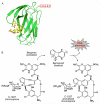Engineered production of cancer targeting peptide (CTP)-containing C-1027 in Streptomyces globisporus and biological evaluation
- PMID: 27094150
- PMCID: PMC4972678
- DOI: 10.1016/j.bmc.2016.04.017
Engineered production of cancer targeting peptide (CTP)-containing C-1027 in Streptomyces globisporus and biological evaluation
Abstract
Conjugation of cancer targeting peptides (CTPs) with small molecular therapeutics has emerged as a promising strategy to deliver potent (but typically nonspecific) cytotoxic agents selectively to cancer cells. Here we report the engineered production of a CTP (NGR)-containing C-1027 and evaluation of its activity against selected cancer cell lines. C-1027 is an enediyne chromoprotein produced by Streptomyces globisporus, consisting of an apo-protein (CagA) and an enediyne chromophore (C-1027). NGR is a CTP that targets CD13 in tumor vasculature. S. globisporus SB1026, a recombinant strain engineered to encode CagA with the NGR sequence fused at its C-terminus, directly produces the NGR-containing C-1027 that is equally active as the native C-1027. Our results demonstrate the feasibility to produce CTP-containing enediyne chromoproteins by metabolic pathway engineering and microbial fermentation and will inspire efforts to engineer other CTP-containing drug binding proteins for targeted delivery.
Keywords: C-1027; Cancer; Cancer targeting peptide (CTP); Enediyne; Streptomyces globisporus.
Copyright © 2016 Elsevier Ltd. All rights reserved.
Figures



Similar articles
-
An NGR-integrated and enediyne-energized apoprotein shows CD13-targeting antitumor activity.Biomed Pharmacother. 2013 Mar;67(2):164-71. doi: 10.1016/j.biopha.2012.10.018. Epub 2012 Nov 19. Biomed Pharmacother. 2013. PMID: 23206754
-
Genes for production of the enediyne antitumor antibiotic C-1027 in Streptomyces globisporus are clustered with the cagA gene that encodes the C-1027 apoprotein.Antimicrob Agents Chemother. 2000 Feb;44(2):382-92. doi: 10.1128/AAC.44.2.382-392.2000. Antimicrob Agents Chemother. 2000. PMID: 10639366 Free PMC article.
-
Draft genome sequence of Streptomyces globisporus C-1027, which produces an antitumor antibiotic consisting of a nine-membered enediyne with a chromoprotein.J Bacteriol. 2012 Aug;194(15):4144. doi: 10.1128/JB.00797-12. J Bacteriol. 2012. PMID: 22815456 Free PMC article.
-
Improvement of the enediyne antitumor antibiotic C-1027 production by manipulating its biosynthetic pathway regulation in Streptomyces globisporus.J Nat Prod. 2011 Mar 25;74(3):420-4. doi: 10.1021/np100825y. Epub 2011 Jan 21. J Nat Prod. 2011. PMID: 21250756 Free PMC article.
-
Enediynes: Exploration of microbial genomics to discover new anticancer drug leads.Bioorg Med Chem Lett. 2015 Jan 1;25(1):9-15. doi: 10.1016/j.bmcl.2014.11.019. Epub 2014 Nov 14. Bioorg Med Chem Lett. 2015. PMID: 25434000 Free PMC article. Review.
Cited by
-
Enediyne natural product biosynthesis unified by a diiodotetrayne intermediate.Nat Chem Biol. 2024 Sep;20(9):1210-1219. doi: 10.1038/s41589-024-01636-y. Epub 2024 Jun 3. Nat Chem Biol. 2024. PMID: 38831037
-
Strain Prioritization and Genome Mining for Enediyne Natural Products.mBio. 2016 Dec 20;7(6):e02104-16. doi: 10.1128/mBio.02104-16. mBio. 2016. PMID: 27999165 Free PMC article.
-
Resistance to Enediyne Antitumor Antibiotics by Sequestration.Cell Chem Biol. 2018 Sep 20;25(9):1075-1085.e4. doi: 10.1016/j.chembiol.2018.05.012. Epub 2018 Jun 21. Cell Chem Biol. 2018. PMID: 29937405 Free PMC article.
-
Discovery of Alternative Producers of the Enediyne Antitumor Antibiotic C-1027 with High Titers.J Nat Prod. 2018 Mar 23;81(3):594-599. doi: 10.1021/acs.jnatprod.7b01013. Epub 2018 Jan 18. J Nat Prod. 2018. PMID: 29345939 Free PMC article.
References
Publication types
MeSH terms
Substances
Grants and funding
LinkOut - more resources
Full Text Sources
Other Literature Sources
Miscellaneous

